
Selecting the right pneumatic actuated ball valve means you need to follow some important steps:
- Figure out how much torque you need, including breakaway and running torque, so the valve works well.
- Check what kind of media you have, the process conditions, and the air supply pressure.
- Add extra safety, usually about 20%, to handle things that might change in real life.
- Make sure the valve fits with ISO 5211 mounting so you do not have mechanical problems.
- Pick the actuator type that matches your valve’s torque needs.
If you skip these steps, you might get leaks, failures, or waste energy. Doing each step helps you avoid expensive mistakes and makes sure the pneumatic ball valve works better than an electric ball valve or a standard ball valve.
Importance of Correct Selection
System Performance
Picking the right pneumatic actuated ball valve is very important. It helps the system work well and without problems. When engineers choose the correct valve and actuator, they can control how liquids or gases move. This control keeps the process steady and stops sudden changes that could mess things up.
- Pneumatic actuated ball valves help control how much media moves. They do this by opening, closing, or changing the valve. This is very important for how the system works.
- Pneumatic actuators use energy to move the valve. This makes the valve work well and in the same way every time.
- Things like solenoid valves, limit switches, and position sensors help control the valve better. They also make the system more reliable.
- Following standards like ISO 5211 makes sure the actuator and valve work together. This helps the system stay strong and work well.
A good valve choice helps with automation and means people do not have to do as much by hand. This lowers mistakes and makes results more steady. The right valve lets the system handle changes in pressure, temperature, and flow without losing control.
Safety and Reliability
Safety and reliability depend on picking and sizing the valve correctly. If the valve does not fit the job, it might stick, leak, or break. These problems can be dangerous. They can cause leaks of harmful media or sudden jumps in pressure. A good valve keeps workers, equipment, and the environment safe.
Engineers need to think about the type of media, pressure, and temperature when picking a valve. Using the wrong materials or actuator size can make accidents more likely. Picking the right valve also means it will answer control signals fast and correctly. This is very important for safety and emergency stops.
Tip: Always check that the valve materials and actuator specs are good enough for the job. This helps stop surprise problems and makes the system last longer.
Cost Risks
Picking the wrong valve can cost a lot of money. You might lose production, need emergency repairs, or get fined. The table below shows some common cost risks and what they can do:
| Cost Implication Category | Description & Examples | Impact on Downtime and Repair Costs |
|---|---|---|
| Lost Production Revenue | Unplanned shutdowns in continuous operations can cost tens of thousands of dollars per hour. | Direct revenue loss during valve downtime. |
| Emergency Maintenance Premiums | Reactive maintenance requires overtime labor, emergency logistics, and non-stocked parts costing 2–3x planned maintenance. | Increased repair costs and extended downtime. |
| Product Loss and System Damage | Valve failures causing sticking or leakage can lead to product contamination, system overpressure, or shutdowns. | Additional costs from lost product and system repairs. |
| Regulatory and Environmental Fines | Fugitive emissions or leaks can result in fines, cleanup costs, or license suspensions. | Financial penalties and potential operational halts. |
| Design Flaws (Material Selection) | Incorrect materials (e.g., stainless steel in chloride environments) cause corrosion and failure. | Leads to premature valve failure and costly repairs. |
| Design Flaws (Seal and Packing) | Weak seal geometry causes leakage and emissions, increasing maintenance needs. | Frequent repairs and downtime. |
| Design Flaws (Actuator Specification) | Under-specified actuators can stick or fail, causing emergency shutdowns. | Extended downtime and emergency repair costs. |
| Lack of Standardization | Proprietary designs limit parts availability, extending repair time. | Longer downtime and higher repair expenses. |
| Real-World Case Example | A gas processing plant experienced a 36-hour shutdown with $200K product loss and $80K emergency costs due to wrong valve and actuator selection. | Illustrates high financial impact of wrong valve choice. |
| Smart Design Benefits | Modular design, certified seals, and digital diagnostics can reduce maintenance time by 40–60% and eliminate 90% of failure modes. | Lower long-term repair costs and reduced downtime. |
Choosing the right pneumatic actuated ball valve lowers these risks. It helps companies stop surprise shutdowns, spend less on repairs, and avoid fines. Smart design choices also make the system last longer and break less often.
Application Requirements
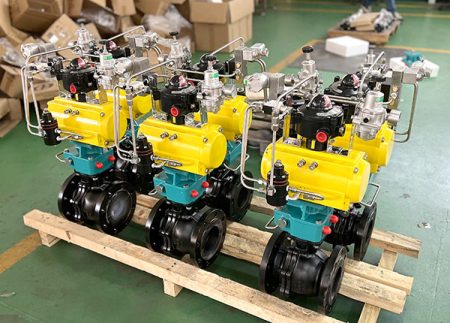
Media Compatibility
To pick the right pneumatic actuated ball valve, you need to know what kind of media is in your system. Different media types can cause different problems. Engineers have to choose the right valve design and materials for the media. This helps stop the valve from breaking.
Corrosive or Abrasive Media
Corrosive or abrasive media can hurt normal valves fast. Stainless steel, like AISI 304 or 316L, does not rust easily. It works well in chemical or clean jobs. PTFE seats seal tightly for pure media, like food or medicine. V-port valves are good for gritty or stringy flows. Powder-coated or galvanized finishes help the valve last longer in tough places.
- The valve type and port shape are important. For example:
- 3-way (L/T port) valves can mix or move chemicals.
- V-port valves are better for rough or stringy media.
- Picking the right material helps stop rust and damage.
- How you move the valve matters too. Pneumatic actuators work fast and are safe for explosive areas.
Note: Always make sure the inside parts of the valve match the media. This stops leaks or early breaks.
Clean vs. Dirty Fluids
Clean fluids, like filtered water or pure gases, can use normal valves. Dirty fluids with bits or sludge need strong seals and easy-to-clean surfaces. Full-port valves are often used for dirty media to stop clogs. PTFE or strong seats keep the seal tight, even with dirt.
Pressure and Temperature
Max/Min Operating Conditions
Every valve must fit the pressure and temperature of the job. Most valves handle pressures from PN16 to PN40 (150-300 PSI). This is good for water, oil, and gas. High-temperature alloys can take heat up to +450°C for steam or oil jobs. Cryogenic valves work in cold down to -196°C for LNG or cold gases. The right size keeps the valve safe and working well.
- Always check the valve’s pressure and temperature before you put it in.
- Make sure the actuator is strong enough for the highest pressure.
Environment
Indoor/Outdoor
Where you put the valve changes how it works. Outside, valves get rain, sun, and hot or cold weather. Inside, things are more steady but can still have dust or wet air. Special coatings and covers help valves last longer outside.
Chemical or Moisture Exposure
Things like dust, chemicals, and wet air can make valves wear out faster. Dust can get in moving parts and cause damage or block air. Chemical vapors can rust metal and ruin seals. Wet air can make the inside rust and build up sludge, making the actuator less exact.
- Use materials and coatings that resist chemicals for tough places.
- Check and seal the valve often to stop dust and wet air from causing problems.
Tip: Look at the whole area before you pick a valve. This helps stop surprise problems and makes the system last longer.
Pneumatic Actuated Ball Valve Selection
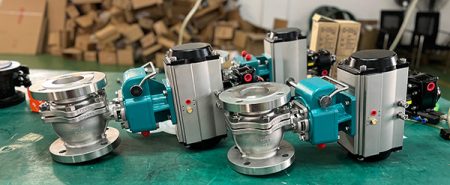
Valve Size and Type
Picking the right valve size and type is very important. The correct size helps the pneumatic actuated ball valve work safely. Engineers must match the valve size to how much flow is needed. They also check the pressure ratings for the system. The table below lists common valve series, materials, actuator types, connection types, size ranges, and how much they can handle in industrial jobs:
| Valve Series | Valve Type & Material | Actuator Types | Connection Type | Size Range | Max Pressure | Max Temperature |
|---|---|---|---|---|---|---|
| P2 | Full Port PVC or CPVC 2-way Ball Valve | Electric, Pneumatic, Manual | NPT or Glue Socket | 1/2″ to 4″ | 232 PSIG (@ 73°F) | PVC: 140°F, CPVC: 212°F |
| SM | Full Port or with Trim Disc Brass 2-way Ball Valve | Sure-mount Electric (On/Off or Modulating) | NPT | 1/2″ to 2″ | 360 PSI | 158°F |
| 101 | Full Port, 2-piece, Nickel Plated Brass 2-way Ball Valve | Electric, Pneumatic, Manual | NPT | 3/8″ to 3″ | 900 PSIG (varies by size) | 300°F |
| 21 | Full Port, 2-piece, Stainless Steel 2-way Ball Valve | Manual | NPT | 1/4″ to 2″ | 1000 PSIG Max | -20 to 400°F |
| 282 | Full Port, 2-piece, Brass 2-way Ball Valve | Manual | NPT | 1/4″ to 4″ | 29inHg Vac. to 600 PSIG (WOG) | up to 366°F |
| 282LF | Full Port, 2-piece, Lead Free Brass 2-way Ball Valve | Manual | NPT, Solder | 1/2″ to 2″ | 29inHg Vac. to 600 PSIG (WOG) | up to 366°F |
| 250LF | Full Port, 2-piece, Lead Free Brass 2-way Ball Valve | Electric, Pneumatic, Manual | NPT | 1/2″ to 2″ | 29inHg Vac. to 150 PSIG (WOG) | up to 302°F |
| 26 | Full Port, 2-piece, 316SS 2-way Ball Valve | Electric, Pneumatic, Manual | NPT | 1/4″ to 3″ | 2000 PSIG (varies by size) | 400°F |
Pneumatic actuated ball valves use air to open and close fast. These valves can move in less than a second. They are used in machines and factories that have air systems. Pneumatic actuators last a long time, sometimes up to one million uses. They also have safety features, like failsafe operation. This can be done with double-acting or spring-return designs. Engineers pick pneumatic actuators for jobs that need lots of opening and closing. They are also good when failsafe operation is needed.
Material Selection
Choosing the right material helps the valve last longer. The best material keeps the valve safe from rust, high pressure, and strong chemicals. Here are some common materials and what they are used for:
- Stainless steel does not rust and lasts a long time. It is best for chemical plants, water cleaning, oil, and gas pipes.
- Brass and lead-free brass are good for less harsh fluids and normal factory use.
- PVC and CPVC are good for water and many chemicals at lower heat and pressure.
- Carbon steel, epoxy-coated cast iron, and epoxy-coated ductile iron are strong for high-pressure jobs.
- Special coatings and stainless steel are good for salty air or places with strong cleaners.
Engineers must think about the media, pressure, and temperature when picking materials. Stainless steel and special coatings protect the valve actuator in tough places. These materials help stop leaks and keep the valve working well in hard jobs.
Tip: Always pick a valve actuator material that matches the media and place. This helps stop early breaks and lowers repair costs.
Mounting Interface (ISO 5211)
The ISO 5211 mounting interface is very important for picking a pneumatic actuated ball valve. This standard tells the size and shape for how the actuator connects to the valve. When engineers use ISO 5211, valves and actuators from different brands fit together. This makes it easier to put in, fix, or swap parts. It also means you do not need lots of special parts and can use the same parts worldwide.
A valve actuator with ISO 5211 is easy to add and works well. Maintenance teams can change actuators or valves without making new parts. This makes work faster and keeps the pneumatic actuated ball valve system working for a long time.
Note: Always check that both the valve and actuator follow ISO 5211. This makes sure they fit well and work for a long time.
Pneumatic Actuator
Picking the right pneumatic actuator is very important for making sure the valve works well. The actuator controls how the valve moves, how fast it reacts, and what happens if the power or air stops. Engineers need to pick the actuator type that matches what the process needs, what is safe, and how the system is built.
Double Acting vs. Single Acting Drives
Pneumatic actuators have two main types: double acting and single acting (spring return). Each type has its own good points and is best for different jobs. The table below shows how these two actuator types are different:
| Aspect | Double Acting (DA) Pneumatic Actuators | Single Acting (Spring Return, SR) Pneumatic Actuators |
|---|---|---|
| Operating Mechanism | Uses compressed air in two chambers to move the piston in both directions. | Uses compressed air in one chamber; spring returns piston to default position when air is lost. |
| Air Supply Requirement | Requires air supply for both opening and closing. | Requires air supply only for one direction; spring provides return action. |
| Force and Speed | Provides high force output and fast action. | Generally lower force; simpler and slower due to spring return. |
| Fail-Safe Capability | No inherent fail-safe; valve position depends on air supply. | Provides fail-safe operation by returning to a predefined position on air loss. |
| Typical Applications | Large industrial applications needing fast, powerful actuation (oil, chemical, power generation). | Safety-critical systems requiring fail-safe (fire safety), smaller or cost-sensitive control systems. |
| Design Complexity and Cost | More complex and typically higher cost. | Simpler design and more cost-effective. |
A double acting actuator uses air to move the valve actuator both ways. This type gives strong force and quick movement. Engineers pick double acting pneumatic actuators for big valves or when things need to move fast. These actuators are used in oil plants, chemical factories, and power plants. They need air to open and close the valve actuator.
A single acting actuator, also called a spring return actuator, uses air to move the valve actuator one way. When the air stops, a spring pushes the valve actuator back to its starting spot. This makes the valve actuator go to a safe place if air is lost. Engineers use single acting pneumatic actuators in places where safety is very important, like fire safety or emergency stops. These actuators are easier to build and usually cost less.
Tip: If safety is very important, pick a single acting actuator. This makes sure the valve actuator goes to a safe spot if air is lost.
Normally Closed (NC) vs. Normally Open (NO) Actuator Configurations
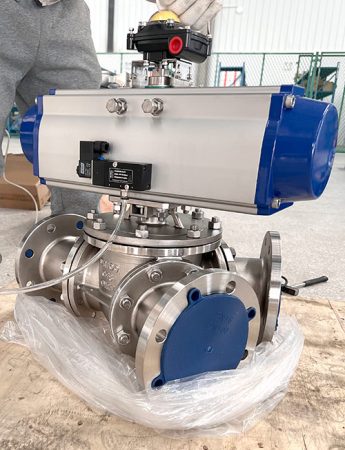
The actuator setup tells what the valve actuator does if the air stops. There are two main setups: normally closed (NC) and normally open (NO).
- A normally closed actuator keeps the valve actuator shut when there is no air. When air comes, it opens the valve actuator. This is good for stopping flow if something goes wrong.
- A normally open actuator keeps the valve actuator open when there is no air. When air comes, it closes the valve actuator. This is good for jobs that need to keep moving unless told to stop.
Engineers must pick the right setup for safety. For example, in a fuel line, a normally closed actuator shuts off fuel if air is lost. In a water cooling system, a normally open actuator keeps water moving so things do not get too hot.
Some things to think about when picking NC or NO actuator setups are:
- What the process needs for safety
- Where you want the valve actuator to be if air is lost
- How the system is controlled
Note: Always check the fail-safe spot of the valve actuator when planning. This helps stop surprise flow or shutdowns if something goes wrong.
A good pneumatic actuator, with the right drive type and setup, makes sure the valve actuator works right every time. This careful choice makes the system safer, more reliable, and better at its job.
Torque Requirements
Breakaway and Running Torque
Breakaway torque is the force needed to start moving a valve. It is higher than the force needed to keep the valve moving, which is called running torque. Pneumatic actuated ball valves need enough breakaway torque to work right. The actuator must give enough force to get past the first resistance. If it does not, the valve might get stuck or not work.
Engineers find breakaway torque by looking at the valve maker’s numbers. They add about 20–30% more for safety. For example, if a valve needs 200 Nm to move, the actuator should give at least 250 Nm. This extra amount helps with things like friction, pressure jumps, and wear. Pneumatic actuators use air to make torque, so they must work fast and well.
Running torque is the force to keep the valve moving after it starts. This is usually less than breakaway torque. But engineers still need to think about it, especially for valves that open and close a lot or work in tough places. Picking the right size and force stops the actuator from stalling and keeps things working smoothly.
Tip: Always pick an actuator for the highest torque needed, not just the average running torque.
Manufacturer Torque Data
Good torque data is very important for picking the right actuator size. Engineers should always check the valve maker’s torque tables. These tables show things like valve size, seat and ball materials, pressure, and design. Torque numbers can change a lot between different valves, so using the right data is important.
- Manufacturer torque tables give the best sizing information.
- These tables include things like seat material, pressure, and valve type.
- Some makers test their valves in labs to get real torque numbers.
- Safety factors are often added to help with problems like sticking after not being used for a while.
- Engineers should talk to experts and use detailed maker data for good sizing and force numbers.
Using the right maker data helps stop actuator problems and makes the system work better. It also helps avoid expensive mistakes when putting in or using the valve.
Service Conditions
Service conditions can change how much torque a valve needs. Things like temperature, pressure, media, and where the valve is all matter. High heat can make more friction inside the valve. Cold can make seals stiff. Dirty or harsh media can make the valve harder to move over time.
Engineers must think about these things when picking pneumatic actuated ball valves. They should add extra safety if the valve will be in tough places. For example, valves outside or in chemical areas may need actuators with more torque. Checking and fixing the valve often also helps keep torque needs steady.
A good actuator, sized for both breakaway and running torque in real conditions, makes sure the valve works well. This stops surprise problems and helps the valve last longer.
Proper Pneumatic Actuator Sizing
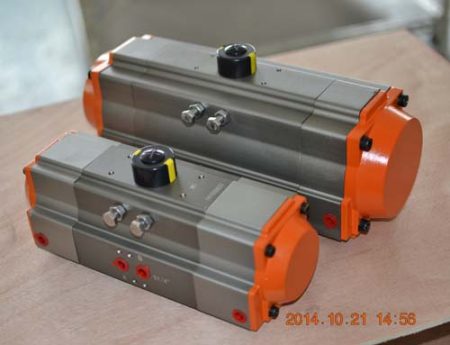
Picking the right actuator for a pneumatic actuated ball valve takes careful planning. Engineers need to think about how much torque is needed, safety extras, actuator type, and real-life conditions. Getting the size right helps the valve and actuator work well, stops breakdowns, and makes them last longer.
Actuator Sizing Factors
Sizing an actuator is more than just matching torque numbers. Engineers look at many things that affect how safe and well the valve works. The table below lists the main things to check:
| Factor | Description | Impact on Sizing and Safety Margins |
|---|---|---|
| Break Torque | This is the first force needed to start turning the valve. It can get higher if the valve sits still or if pressure is high. | The actuator must beat this force. If not, the actuator could be too small. |
| Running Torque | This is the force needed to keep the valve moving. | The actuator must give steady force so the valve moves smoothly. |
| Seating Torque | This is the force needed to close the valve all the way. Ball valves need a bit more. | This includes seal rubbing. It is important for a tight seal and strong actuator. |
| Media Type and Process Conditions | Different media, like dry gas or thick liquids, change how much force is needed. | You may need to change torque numbers and safety extras. Dry gas makes break torque higher. Thick liquids make closing harder. |
| Safety Margin | It is smart to add at least 20% extra force for safety. This helps with surprise loads, wear, or weather changes. | This stops actuator failure and keeps things working even if conditions change. |
| Air Supply Pressure | Pneumatic actuators need steady air pressure, usually 60 or 80 psi, to work right. | If air pressure drops, torque drops too. The safety margin helps with this. |
| Mechanical Compatibility | ISO 5211 mounting and good stem fit stop wear and problems. | This makes sure the actuator and valve fit right and do not wear out fast. |
| Common Mistakes | Picking an actuator that is too small, too big, the wrong type, or does not fit right. | This can make the valve not open or close all the way, cost more, or break early. |
Safety Margins
Engineers always add extra force when picking actuator size. They usually add 20–30% more than the most torque the valve needs. This extra helps with surprise loads, wear, or weather changes. For example, if a valve needs 100 Nm, the actuator should give at least 120–130 Nm. This keeps the actuator from failing and helps the system work even if things change.
Note: Actuators should have overload protection, like thermal or electronic safety, and position feedback. These features help keep things safe and make actuators last longer.
Seal Friction and Pressure
Seal friction makes it harder to move the valve. Engineers must count this when sizing actuators. High-pressure systems or tight seals need more force to work. The media type matters too. Dry gases can make break torque higher. Thick liquids can make closing harder. Always use the maker’s torque data that matches real-life use.
Rack-and-Pinion vs. Scotch Yoke
Engineers pick rack-and-pinion or scotch yoke actuators based on what the job needs. Both types turn straight motion into turning motion, but they work a bit differently.
- Rack-and-pinion actuators give the same force all the way through the stroke. This makes them smooth and easy to control. Engineers use them for small or medium ball valves that need to be very exact.
- Scotch yoke actuators give more force at the start and end of the stroke. This is good for big or tough valves that need lots of force to start moving. Scotch yoke actuators are bigger and cost more, but they are great for hard jobs.
The best actuator depends on valve size, how much force is needed, and if you need exact or strong movement. Rack-and-pinion actuators work for most normal ball valves. Scotch yoke actuators are for tough, high-force jobs.
Sizing for Spring Return Actuators
Spring return actuators, also called single acting actuators, use a spring to move the valve to a safe spot if air stops. Sizing these actuators needs extra care. The actuator must give enough force to move the valve and push the spring at the same time. The spring adds more resistance, so engineers must count this when sizing.
Key steps for sizing spring return actuators:
- Find the most torque needed for the valve, including breakaway, running, and seating torque.
- Add at least 20% extra for safety.
- Check the actuator’s force at the lowest air pressure, since the spring lowers the force.
- Make sure the actuator can move the valve to its safe spot if air is lost.
Tip: Always use the maker’s data and add extras for real-life things, like temperature changes or media buildup. This makes sure the actuator works right in all situations.
Getting the size right for spring return actuators stops the valve from getting stuck and makes sure it moves to the safe spot in emergencies.
Air Supply and Control
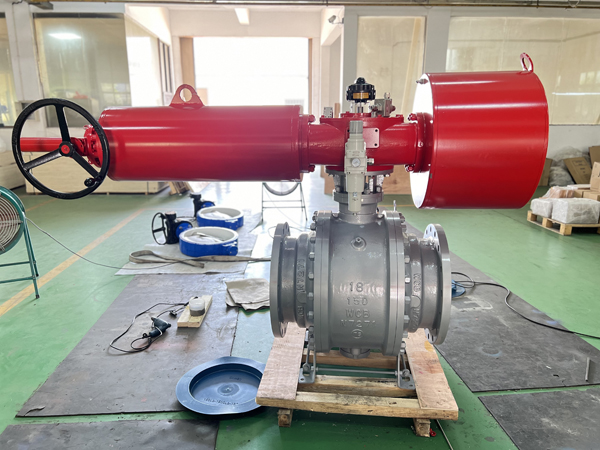
Air Pressure and Flow
A steady air supply is very important for pneumatic actuated ball valves. Most actuators in factories need air between 60 and 100 psi to work well. If the air drops below 40 to 60 psi, the actuator might not move the valve right. This can make the valve move weakly or not at all. Keeping the right air pressure helps the actuator push past friction and loads. Workers should watch the air supply and use regulators to keep it in the safe range. Good air flow also helps the actuator move the valve fast and correctly.
Air Quality and Filtration
Clean air helps the actuator last longer. Dust, oil, and water in the air can hurt seals and moving parts. Dirty air can make the actuator stick or stop working over time. Air filters and dryers take out these bad things from the air line. Checking and cleaning filters often makes the actuator and system last longer. Clean air means less downtime and keeps the valve working well.
Control Devices
Pneumatic Solenoid Valves
Pneumatic solenoid valves control how air gets to the actuator. When the control system sends a signal, the solenoid valve opens or closes. This lets air move the actuator and change the valve’s position. Engineers pick solenoid valves by voltage, speed, and if they fit the actuator. Good wiring and mounting stop leaks and electrical problems. Solenoid valves should match the actuator’s air needs and work in the right place.
Valve Positioners
Valve positioners help the actuator move the valve to exact spots. They get a signal and change the air going to the actuator. This lets the valve move to many positions, not just open or closed. Positioners are needed when the flow must be changed a little at a time. Picking a positioner depends on the signal type, if it fits the actuator, and where it will be used.
Limit Switch Boxes
Limit switch boxes tell the control system if the valve is open or closed. They send signals when the valve reaches these spots. This helps workers check if the actuator is working right and find problems fast. Engineers pick limit switch boxes by how strong the box is, what kind of switch it uses, and how easy it is to connect.
Manual Override (Handwheel) Options
Manual override lets workers move the valve by hand if the air system fails. Handwheels or levers are put on the actuator for this. These are important for safety and fixing things. The choice depends on how big the actuator is and if emergency use is needed.
Air Boosters and Lock-Up Valves
Air boosters make the air stronger or move faster to the actuator. They help when air lines are long or actuators are big and need more force. Lock-up valves keep the actuator in place if the air stops. Both devices help the system work better and are picked by actuator size and job needs.
Tip: Always pick control devices that fit the actuator and the job. This helps everything work smoothly and lowers the chance of problems.
Sizing for Special Conditions

Hazardous Locations
Pneumatic actuated ball valves in hazardous places must follow strict safety rules. These areas can have gases, vapors, or dust that might catch fire if there are sparks or heat. To keep things safe, engineers pick valves and actuators with special safety labels and designs.
- Labels like ATEX, IECEx, NEC, and CSA show the equipment is safe for places with explosions.
- Explosion-proof designs use sealed cases and thick metal to stop sparks or heat from getting out.
- Stainless steel or special metals help the valve resist damage from strong chemicals.
- Anti-static parts and good grounding lower the chance of static electricity starting a fire.
- Fire-safe rules, like API 607, make sure the valve stays strong during a fire.
- All parts, like solenoid valves and positioners, must be safe for dangerous areas.
- Marks from groups like UL or ETL show the equipment meets safety rules.
- Keeping records and following rules like IEC 61508 helps with safety checks.
- Checking, fixing, and installing things right, like grounding, keeps everything safe.
Note: Pneumatic actuators are often picked for dangerous places because they do not cause sparks.
Extreme Temperatures
Very hot or cold places can make pneumatic actuated ball valves work harder. Both high and low temperatures can change how strong the materials are and how well the seals work. Engineers must pick materials and designs that can handle these tough conditions.
Valve bodies need to be strong and not change shape with heat or cold. Stainless steel, like 316L, works for most jobs. For hotter or more chemical places, duplex stainless steel or nickel alloys are better. Valve seats and cores need to handle heat and wear, so Stellite alloy or tungsten carbide ceramics are used. Valve stems must not bend or break, so strong alloys are picked. Packing, seals, and gaskets should stay soft and stretchy, even with big temperature changes or chemicals.
Some pneumatic actuators, like the Bray Series 92/93, work from -18°C to 176°C, and can take short bursts up to 250°C. These actuators use special aluminum, coatings, and careful adjustments to work safely. Closed designs help keep dirt out and lower how much fixing is needed.
Tip: Always check that the valve and actuator materials can handle the right temperatures so they do not leak or break.
High Cycle Applications
High cycle jobs need pneumatic actuated ball valves that can open and close many times without breaking. These jobs put extra stress on the valve and actuator, so picking the right parts and taking care of them is very important.
- Picking the right actuator depends on how much force the valve needs, the pressure, and the lowest air pressure you have.
- Pneumatic actuators are best for high cycle jobs because they can open and close a lot without getting too hot or breaking, unlike electric actuators.
- How fast the valve moves changes how much power is needed; faster cycles need more force, and pneumatic actuators can easily change speed.
- Safety features, like spring-return, help keep the valve in the right spot if power or signals stop.
- The material and actuator type (single-acting or double-acting) should fit the job, pressure, and temperature.
- Putting the valve in straight and setting it up right stops extra stress and helps it work well.
- Checking for air leaks, making sure the actuator is lined up, adding oil, and cleaning help the valve last longer and work better.
Regular checks and care are very important for valves that open and close a lot in tough jobs.
Common Mistakes

Underestimating Torque
Some engineers do not think about how much torque is really needed. If the actuator is not strong enough, the valve might get stuck. It might not open or close all the way. This happens when people only use the average torque and forget about breakaway torque. Over time, seals can get bigger and dirt can build up. This makes the valve even harder to move. If the actuator is too small, leaks can happen. The valve might not shut off right or parts can break.
If the actuator is too small, things can break often. This can stop work and cost a lot of money. But if the actuator is too big, it costs more and wears out the valve faster. Engineers should always check the maker’s torque numbers. They should add extra force for safety. Checking the actuator often helps make sure it still works as things change.
Ignoring Environment
Not thinking about where the valve is used can be risky. It can make the valve break early or cause safety problems. Things like heat, pressure, what flows inside, and chemicals all matter. If you pick the wrong material for the valve, it can rust or leak. It might even break suddenly.
The table below shows how different things in the environment can hurt pneumatic actuated ball valves and what can go wrong if you do not pay attention:
| Environmental Factor | Impact on Pneumatic Actuated Ball Valves | Consequences of Neglect | Preventive Measures |
|---|---|---|---|
| Media Compatibility | Elastomer parts can wear out | Seals break, leaks, faster wear | Pick elastomers that work with the media |
| Material Compatibility | Some media can eat away valve parts | Parts wear out and break too soon | Use valve materials that fit the media |
| Pressure and Temperature | Too much can wear out or break the valve | Valve stem breaks, seals leak | Make sure valve specs fit the job |
| Maintenance | Not taking care of the valve causes damage | Parts wear out, dirt builds up | Clean, oil, and check the valve often |
| Installation and Actuator | Wrong setup or actuator can cause stress | Valve or actuator can break | Use the right actuator and check the setup |
| Abrupt Pressure Changes | Sudden changes can shake the valve | Valve can break from pressure surges | Use slow actuators and good pipes |
| Particulates in Media | Grit can wear out seals and parts | Seals and valve wear out faster | Keep solids out or use smooth media |
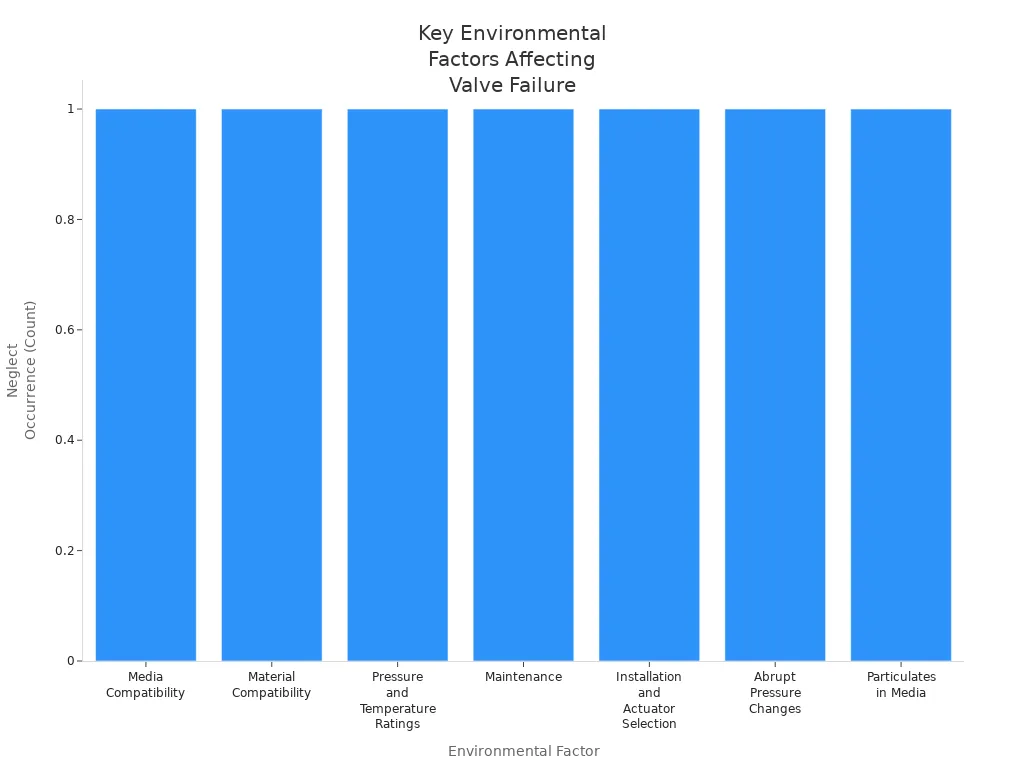
If a valve faces harsh chemicals or heat and is not made for it, it will break faster. Dust, water, and sudden pressure changes also hurt seals and moving parts. Checking the valve often, putting it in right, and picking the best materials help stop these problems. Engineers should always look at the whole place before picking a valve.
Tip: Always pick valve material and design that fits where it will be used. This helps stop early breaks and extra repairs.
Overlooking Air Supply
Pneumatic actuated ball valves need good air to work right. If the air pressure is too low, the actuator might not move the valve. Dirty air with dust or water can block or hurt the inside parts. This can make the valve slow, not move all the way, or stop working.
Sometimes, engineers forget to check the air system when there are valve problems. They should watch the air pressure, flow, and how clean it is. Air filters and dryers help keep bad stuff out. Taking care of the air system helps the actuator get the right air.
Bad or dirty air can make the valve act strange. This can stop work, cause safety problems, or wear out the valve and actuator faster. Keeping the air system clean and strong helps the valve work well and last longer.
Mounting Issues
If you do not mount pneumatic actuated ball valves the right way, big problems can happen. Many times, things go wrong because the valve and actuator are not connected right. If the mounting is off, the valve might not open or close all the way. This can make leaks, cause parts to wear out faster, or even break the whole system.
Some common mistakes when mounting are:
- The actuator and valve stem are not lined up right.
- The wrong ISO 5211 mounting pad or bolts are used.
- Bolts are too tight or too loose.
- Gaskets or seals are not used when needed.
- Heavy valves do not have support brackets.
If the actuator and valve are not lined up, the stem can bend or snap. This puts extra pressure on seals and bearings. Over time, the valve might start leaking or get stuck. Using the wrong bolts or pads can make the valve shake or move when it works.
Tip: Always use the manufacturer’s instructions for mounting. Pick the right bolts and check that everything lines up before you tighten them.
A simple checklist can help stop mounting problems:
- Look at the mounting pad and stem for any damage.
- Make sure the actuator fits the valve’s ISO 5211 pattern.
- Use bolts that are the right size and strength.
- Line up the actuator and valve stem carefully.
- Tighten bolts in a cross shape so the pressure is even.
- Add support brackets if the valve is big or heavy.
Mounting the valve the right way helps it work smoothly and last longer.
Maintenance Oversights
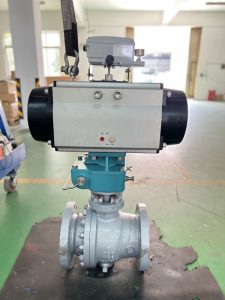
Not taking care of pneumatic actuated ball valves is a common mistake. Regular checks and care keep the system safe and working well. If you skip maintenance, small problems can turn into big ones.
Some key things people forget are:
- Not checking for leaks or worn parts often enough.
- Forgetting to add oil or grease to moving parts.
- Not cleaning or changing air filters and dryers.
- Not checking if the actuator moves and gives feedback.
- Not looking at seals and gaskets to see if they are okay.
If you do not do maintenance, the valve can get stuck, leak, or not answer control signals. Dirty air can block the actuator or hurt the seals. Worn seals can let media leak out, which is not safe and can waste product.
The table below shows what can happen if you do not do maintenance:
| Oversight | Possible Result | System Impact |
|---|---|---|
| No lubrication | More friction | Valve sticks or wears |
| Dirty air supply | Seal damage, clogging | Actuator fails |
| Ignored leaks | Media loss, corrosion | Safety risk |
| Skipped inspections | Missed early warnings | Costly repairs |
Note: Make a maintenance schedule using the manufacturer’s advice and how much you use the system.
A good plan for maintenance means checking, cleaning, adding oil, and changing old parts on time. Keeping notes about maintenance helps find problems early and stop them from coming back. Taking care of the valve helps it work safely and last a long time.
Ensuring Reliability
Material and Seal Choices
Picking the right materials and seals helps the pneumatic actuated ball valve last a long time. Engineers first look at what fluid will go through the valve. They also check the temperature and pressure. Stainless steel does not rust and is good for tough places. Brass is used for jobs with low pressure. Carbon steel can take high heat. Plastics are light and do not rust, but are best for easier jobs.
Seals are very important for how well the valve works. PEEK seals are strong and last a long time. They work well when there is a lot of pressure or heat. This makes them great for oil, gas, and power plants. PTFE seals do not react with chemicals and help the valve move smoothly. They are used in food, drinks, medicine, and chemical plants. PEEK is best for hard jobs because it is tough and lasts long. PTFE is cheaper and works well when you need chemical safety and easy movement.
- Pick valve body materials that fit the fluid, temperature, and pressure.
- Use PEEK seals for jobs with lots of stress, heat, or pressure.
- Choose PTFE seals for chemical safety and smooth working.
- Make sure the valve size is right to keep flow and efficiency high.
- Follow rules like ANSI, ASME, API, and ISO for safety and quality.
Tip: Always match the seal and body material to the job for the best results over time.
Inspection and Maintenance
Checking and taking care of pneumatic actuated ball valves helps them work safely and well. Teams should look for leaks and check the actuator often. They should also test if the valve opens and closes right. Adding oil or grease to moving parts stops them from wearing out. Using special tools to watch for problems helps teams fix things before they break.
- Look for leaks and worn-out parts.
- Test if the actuator and valve move as they should.
- Oil or grease moving parts when needed.
- Use tools to watch for problems and plan fixes early.
- Keep valves in clean, dry places so seals and seats stay safe.
A good plan for care helps the valve last longer and stops surprise shutdowns.
Supplier Selection
Picking the right supplier helps every pneumatic actuated ball valve work better. Good suppliers have strong checks for quality and safety. Look for ISO 9001, API 6D, API 607, and ATEX marks. These show the supplier follows strict rules.
How the supplier makes the valves is important too. Suppliers with new machines and careful checks make better valves. They look at materials, check during making, and test each valve. Keeping track of parts and using numbers helps find problems early.
Help after buying is also important. Good suppliers give technical help, spare parts, fixing services, and training. They answer fast in emergencies and help keep things running.
| Supplier Criteria | Why It Matters |
|---|---|
| Certifications | Shows they meet quality and safety rules |
| Manufacturing Capability | Means the product works well every time |
| After-Sales Support | Gives help, parts, and training when you need it |
Note: Working with a good supplier helps the system last longer and gives peace of mind.
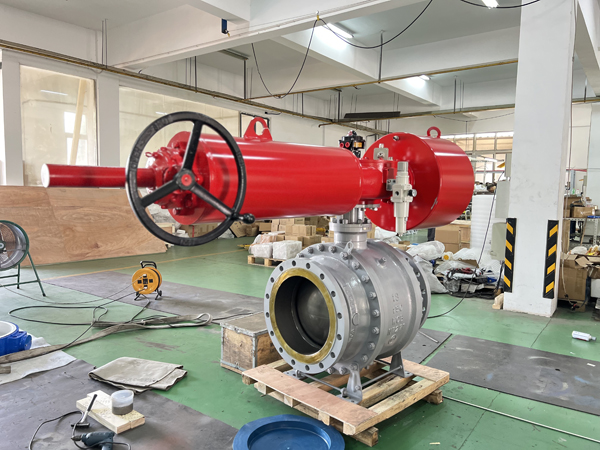
Picking the right pneumatic actuated ball valve means you must think about torque, material, actuator type, and where it will be used. Following steps one by one helps engineers stop expensive errors and makes the system work better.
- Check everything your application needs before you choose.
- Look at the manufacturer’s numbers for size and safety.
- Ask trusted suppliers or experts if the project is hard.
Tip: Doing things in order keeps the valve safe, works well, and lasts a long time.
FAQ
What is the main advantage of a pneumatic actuated ball valve?
A pneumatic actuated ball valve can open and close very fast. It is great for machines that work by themselves. This valve gives strong shutoff and good control in many factories.
How does a pneumatic actuator fail-safe function work?
A spring return actuator moves the valve to a safe spot if air stops. This keeps people and equipment safe when there is an emergency.
Can a pneumatic actuated ball valve handle corrosive fluids?
Yes. Engineers use stainless steel or PTFE seats for these fluids. Picking the right material stops leaks and helps the valve last longer.
How often should maintenance occur on these valves?
Teams should check pneumatic actuated ball valves every six months. Regular checks help find leaks, worn parts, or air problems early.
What air pressure is needed for most pneumatic actuators?
Most pneumatic actuators need air between 60 psi and 100 psi. Always look at the manufacturer’s guide for the right pressure.
Are pneumatic actuated ball valves suitable for outdoor use?
Yes. For outside use, you need weatherproof actuators and strong materials. Special coatings and covers help the valve last longer in tough weather.
How do you know if the valve is open or closed?
Limit switch boxes send signals to the control system. These signals tell if the valve is open or closed. Operators can check the valve from far away.
